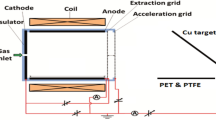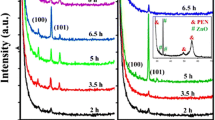Abstract
The research successfully revealed the fabrication of Cu-doped ZnO nanorods grown on flexible polyethylene terephthalate (PET) substrate using chemical bath deposition method. The grown Cu-doped ZnO nanorods have been systematically characterized by X-ray diffraction, field-emission scanning electron microscopy and photoluminescence spectroscopy. The low compressive strain, strong and sharp (0 0 2) peak of the Cu-doped ZnO nanorods revealed a high-quality crystal structure. The average diameters of the undoped and Cu-doped ZnO nanorods grown on the PET substrate were 60 and 75 nm, respectively. The photoluminescence study exhibited an increased intensity in UV emission and decreased intensity in green emission with Cu doping. The current–voltage measurements demonstrate that the current level (with the bias voltage of + 5 V) increases from 205 µA to 1.83 mA with doping Cu into the ZnO nanorods. The well-aligned Cu-doped ZnO nanorods with high-density and quality crystal structure can be very suitable for applications in optoelectronic devices.





Similar content being viewed by others
References
Hammad TM, Salem JK, Harrison RG, Hempelmann R, Hejazy NK (2013) Optical and magnetic properties of Cu-doped ZnO nanoparticles. J Mater Sci Mater Electron 24:2846–2852
Hashim NH, Subramani S, Devarajan M, Ibrahim AR (2016) Structural and surface characterization of undoped ZnO and Cu doped ZnO using sol–gel spin coating method. J Mater Sci Mater Electron 27:3520–3530
Herng T, Lau S, Yu S, Yang H, Wang L, Tanemura M, Chen J (2007) Magnetic anisotropy in the ferromagnetic Cu-doped ZnO nanoneedles. Appl Phys Lett 90:032509
Iqbal J, Jan T, Shafiq M, Arshad A, Ahmad N, Badshah S, Yu R (2014) Synthesis as well as Raman and optical properties of Cu-doped ZnO nanorods prepared at low temperature. Ceram Int 40:2091–2095
Kouklin N (2008) Cu-doped ZnO nanowires for efficient and multispectral photodetection applications. Adv Mater Deerfield Beach Then Weinheim 20:2190
Lin J-P, Wu J-M (2008) The effect of annealing processes on electronic properties of sol-gel derived Al-doped ZnO films. Appl Phys Lett 92:134103
Lockett AM, Thomas PJ, O’Brien P (2012) Influence of seeding layers on the morphology, density, and critical dimensions of ZnO nanostructures grown by chemical bath deposition. J Phys Chem C 116:8089–8094
Lupan O, Pauporté T, Viana B, Ursaki V, Tiginyanu I, Sontea V, Chow L (2012) UV-blue and green electroluminescence from Cu-doped ZnO nanorod emitters hydrothermally synthesized on p-GaN. J Nanoelectron Optoelectron 7:712–718
Lv J, Liu C, Gong W, Zi Z, Chen X, Huang K, Liu F, Wang T, He G, Song X (2012) Facile synthesis of Zn1 − xCuxO nanorods with a very broad visible band. Electron Mater Lett 8:477–480
Noipa K, Rujirawat S, Yimnirun R, Promarak V, Maensiri S (2014) Synthesis, structural, optical and magnetic properties of Cu-doped ZnO nanorods prepared by a simple direct thermal decomposition route. Appl Phys A 117:927–935
Panda N, Acharya B, Nayak P, Bag B (2014) Studies on growth morphology, UV absorbance and luminescence properties of sulphur doped ZnO nanopowders synthesized by the application of ultrasound with varying input power. Ultrason Sonochem 21:582–589
Peng F, Zhou Q, Zhang D, Lu C, Ni Y, Kou J, Wang J, Xu Z (2015) Bio-inspired design: inner-motile multifunctional ZnO/CdS heterostructures magnetically actuated artificial cilia film for photocatalytic hydrogen evolution. Appl Catal B 165:419–427
Rakhshani A (2014) Visible light emission and UV light detection properties of solution-grown ZnO/polymer heterojunction diodes on stainless steel foil. Appl Surf Sci 311:614–620
Sáenz-Trevizo A, Amézaga-Madrid P, Pizá-Ruiz P, Antúnez-Flores W, Ornelas-Gutiérrez C, Miki-Yoshida M (2015) Single and multi-layered core-shell structures based on ZnO nanorods obtained by aerosol assisted chemical vapor deposition. Mater Charact 105:64–70
Santoshkumar B, Kalyanaraman S, Vettumperumal R, Thangavel R, Kityk I, Velumani S (2016) Structure-dependent anisotropy of the photoinduced optical nonlinearity in calcium doped ZnO nanorods grown by low cost hydrothermal method for photonic device applications. J Alloy Compd 658:435–439
Sarkar S, Basak D (2013) Defect controlled ultra high ultraviolet photocurrent gain in Cu-doped ZnO nanorod arrays: de-trapping yield. Appl Phys Lett 103:041112
Shabannia R (2015) Vertically aligned ZnO nanorods on porous silicon substrates: effect of growth time. Prog Nat Sci Mater Int 25:95–100
Shabannia R (2016) Effects of growth duration and precursor concentration on the growth of ZnO nanorods synthesized by chemical bath deposition. Iran J Sci Technol Trans A Sci 40:19–25
Shabannia R, Abu Hassan H (2014) Growth of Aligned ZnO nanorods grown on polyethylene naphthalate substrates: effect of the growth duration. Adv Mater Res 925:195–199
Shabannia R, Ghasemtabar M (2016) Self-assembly of densely packed ZnO nanorods grown chemically on porous silicon substrate. Iran J Chem Chem Eng (IJCCE) 35:57–61
Shabannia R, Hassan HA (2014) Characteristics of photoconductive UV photodetector based on ZnO nanorods grown on polyethylene naphthalate substrate by chemical bath deposition method. Electron Mater Lett 10:837–843
Shabannia R, Hassan HA, Mahmodi H, Naderi N, Abd H (2013) ZnO nanorod ultraviolet photodetector on porous silicon substrate. Semicond Sci Technol 28:115007
Sharma PK, Dutta RK, Kumar M, Singh PK, Pandey AC, Singh V (2011) Highly stabilized monodispersed citric acid capped nanoparticles: synthesis and characterization for their applications in white light generation from UV LEDs. IEEE Trans Nanotechnol 10:163–169
Srinet G, Kumar R, Sajal V (2013) Effects of Ni doping on structural, optical and dielectric properties of ZnO. Ceram Int 39:7557–7561
Wang R-C, Su W-S (2016) Valence control and periodic structures in Cu-doped ZnO nanowires. J Alloy Compd 654:1–7
Wang Y, Hou Z, Guo H, Shen L, Wang G, Cui F, Zhang Q (2013) Preparation of ZnO nanorods via aqueous solution process and their PL properties. Mater Lett 91:107–110
Zhou P, Liu H, Zhang L, Suo X, Liang Z, Liu Y, Li Y, Jiang Z, Wang Z (2016) Study of substrate temperature and copper doping effects on structural, electrical and optical properties of Cu-doped and undoped ZnO thin films. J Mater Sci Mater Electron 27:7822–7828
Author information
Authors and Affiliations
Corresponding author
Rights and permissions
About this article
Cite this article
Shabannia, R. Structural, Optical and Electrical Properties of Cu-Doped ZnO Nanorods Grown on Flexible Polyethylene Terephthalate Substrate. Iran J Sci Technol Trans Sci 42, 2349–2353 (2018). https://doi.org/10.1007/s40995-017-0370-2
Received:
Accepted:
Published:
Issue Date:
DOI: https://doi.org/10.1007/s40995-017-0370-2




